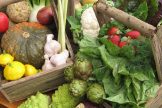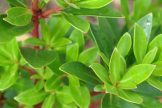Growing your own edible flowers mean you know that they haven’t been sprayed with pesticides and are safe to use. They enhance both the garden and the kitchen and add a gourmet touch to even the most basic dish. Not just for salads and ice cubes, some work with steamed vegies, others on cakes, in fruit salads, a couple can be stuffed, and others have such distinct flavours, they can act as a flavour component for the dish, and yet more are used in herbal teas. Naturally almost all of these flowers work as the ultimate garnish – toss out the sprigs of parsley and toss in those flowers or individual petals.
Another option is to dry the flower petals. There are numerous web pages devoted to this topic. Dried petals look amazing on cakes and cupcakes.
Not all flowers are edible – some are poisonous. Do your research before using just any old flower as a garnish. Flowers listed below are safe to eat, not all taste great though.
 Important note about plant availability. Important note about plant availability.There are hundreds of factsheets on our website provided for your information. Not all plants will be available at all times throughout the year. To confirm availability please call (03) 8850 3030 and ask for the nursery. |
Alliums: These are the round flowers (often but not always, mauve/purple) found on chives, leaks, onions and garlic. The round head can be divided into separate florets. Garlic Chives have white flowers with a strong garlic/onion flavour, very attractive.
Anise Hyssop (Agastache foeniculum): This plant is grown not just for its famously sweet aniseed/mint flavoured leaves, but the long soft purple flower spike can be used as a garnish or separated into tiny florets and added to any dishes that benefit from this colour, flavour and fragrance. A short lived perennial.
Balloon Flower (Platycodon grandifloras): Regularly used in Korean dishes this flower is used both fresh and cooked, in a very wide range of dishes. Blossoms are sweet and have sufficient texture to be good in salads.
Bee Balm/Bergamot (Monarda spp.): A good nectar producing flower, and thus great for attracting butterflies and hummingbirds, the brilliant pinks, purples and reds of this genus add a minty flavour to dishes. A perennial which benefits from periodic dividing (if it looks like the centre is dying back – time to divide).
Borage: Wonderful sky blue flowers (sometimes with a hint of pink) with a sweet flavour. Can be used decoratively, dropped in your G&T, in ice cubes etc.
Broadbean flowers: Lovely white flowers with a black accent. Fabulous tossed through leafy salads and in savoury dishes. Remember, the broad bean pods develop from the flowers – harvesting the flowers will reduce your broad bean harvest.
Calendula: One of our most popular edible flowers the brilliant orange to yellow flowers add a big pop of colour. The plants flower for months and become a favourite in the garden and in the kitchen.
Carrot flowers: Delicate white florets on a large umbel.
Chamomile: Strong herbal fragrance with a milder flavour. Commonly used in teas, but easily used for decorating or adding herbal flavour.
Cornflower (Centaurea cyanus): The blue petals blend perfectly with other colours and can be used from salads to cake decorating. A wonderful edible flower option. Let a few go to seed for next year.
Daylily (Hemerocallis): Use as you would a zucchini flower – very similar in taste and use. Stuff or in stir-fries. Do not use the white base – can be bitter.
Dianthus: Peppery clove like flavour. Can be added anywhere those flavours suit, or as a decoration for cakes or pies. Great with apple cake/pie.
Elderflower: Sambucus nigra var. canadensis is the most common source of Elderflowers. Blossoms appear in late spring into summer, when used fresh they have a lovely sweet fresh and fruity flavour and a rich sweet fragrance. Can also be used dried or preserved into syrups/cordials and wines. This plant also produces the famous elderberries, but these MUST be cooked before use.
Feijoa (Feijoa sellowians): An attractive vivid flower with a lovely sweet flavour. If you are keen to get larger fruit, and want to thin the blossoms a bit, they have a sweet mildly tropical flavour. Can be dropped into drinks or used as a garnish.
Fuchsia: The flavour isn’t the best, but safe to use as an amazing garnish. A good garnish for those very sweet cocktails, as the sweetness overpowers the slight acidity of the flower.
Honeysuckle: Please use only the flowers – the berries are poisonous. Flowers are sweet as per their name and very striking.
Impatiens: Impatiens wallerana: Petals are surprisingly sweet and easy to eat.
Linaria: Great in salads with wonderful colours and a fresh sweet cucumber flavour.
Marigolds: Only use the milder flavored petals not the stronger/tougher green parts.
French marigolds (Tagetes patula): Try before you use – can be bitter, possibly more use as a decoration
African marigolds (Tagetes erecta): Try before you use – can be bitter, possibly more use as a decoration
Mexican mint marigolds (Tagetes lucida): Sometimes known as Mexican tarragon – which indicates its anise like flavour. Often used dried and powdered.
Lemon marigolds (Tagetes tenuifolia): Mild citrus flavour. Very decorative, an be used similarly to Calendula petals.
Mint: Mint flowers are not spectacular in appearance, but are safe to use. There is a very wide range of flavoured mints, and their flowers have a similarly wide flavour range. Good to use in teas.
Mustard Flowers: Commonly bright yellow flowers with, unsurprisingly, peppery mustard flavour.
Nasturtiums: The big bold flowers have a peppery refreshing flavour. Great in salads adding flavour and colour.
Nigella: Nigella damascena Love in a Mist is a blue flowering annual which adds a lovely pop of colour and has a mild grassy flavour.
Pansies / Violas / Violets: All are edible and tend to have very little flavour – mostly used for their bright visual component.
Pea flowers: Generally white with a pea flavour. Great in salads – but remember, the pea pods develop from the flowers – harvesting the flowers will reduce your pea harvest.
Pelargoniums – scented varieties: There is a very wide range of scented pelargoiums, and their flowers have a similarly wide flavour range, roughly corresponding with their scent. Avoid the citronella varieties.
Pineapple sage: Brilliant red flowers add wonderful vivid splash of colour. Very mild flavour.
Rocket (Arugula): small flowers with the classic piquant, peppery rocket flavour. Sensational addition to salads.
Rose: All roses are edible, but the white base of the petal can be a bit bitter. Flavours vary with the deeper reds having the strongest scent and flavour.
Rosemary: pale to mid blue flowers have a mild rosemary flavour.
Snapdragons: Very pretty garnish, but unpleasant flavour. Garnish only.
Zucchini flowers: for the classic stuffed menu item.















